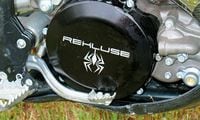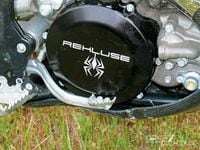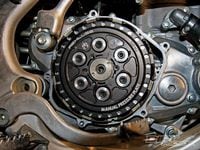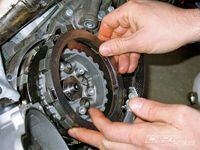Rekluse
Core Clutch With EXP TechnologyRekluse has been viewed as an off-road product company catering to trail riders, even though some pretty high-level enduro racers are not afraid to run the auto-clutches, despite fear of ridicule from fellow riders. Some motocrossers have also run the system, just undercover. Recently Rekluse developed a system, the Core Clutch, and progressed the auto-clutch into a new product, the EXP Clutch -dubbed anti-stall. Sounds confusing and there is a bit of politics involved, but plain and simple, they are onto something.The Core Clutch consists of a center clutch, a matched set of steel drive plates, springs and a manual pressure plate. The Core EXP Clutch adds an EXP friction disk and a special EXP pressure plate. They are two different things, but you can get the additional parts to switch between anti-stall and a standard manual clutch in about 10 minutes if you want to have both. The Rekluse Core Clutches work with your bike's stock friction disks or Rekluse friction disks.Installation of the Core Manual Clutch is a little more complicated than a stocker as it includes an adjustment for the pressure plate engagement, but the instructions spell it all out. Same for the EXP anti-stall system, though this simple auto-clutch stuffed into one oversize clutch plate is much easier than the balls and springs used in the past. There is an oversize gasket for the stock cover, or on some models you can upgrade to a Rekluse cover that makes the necessary extra room ($139). The system is available for 450s and bigger-bore two-strokes now, with 250Fs coming soon.Riding the bike with the $519 Core Manual Clutch is just like riding a bike with a stock clutch and it was hard to tell the difference on either a 2009 Honda CRF450R or a KTM 250 XC, the bikes we sampled the clutches on. There may be a slight difference in lever effort, if anything, but both seemed solid and consistent in performance, just like the high-level stock units. It did seem to hold up to hard riding just a bit better on the Honda, especially during a lot of slipping on rutty tracks. But that was not what we were impressed with.The $799 EXP anti-stall is where it's at. Designed to allow 100 percent normal actuation of the clutch lever at all times and still perform like an auto-clutch, it does a great job. In fact, if you don't tell someone the clutch is in the bike, they tend to ride it just like normal but find that the engagement gets confused sometimes, usually just about the time they would be stalling. But if you can just get it through your thick skull that you don't ever need to touch the clutch lever and then realize the bike will not stall, things get really good and it becomes nearly impossible to kill the engine unless you do something totally abnormal.About the only time you need to touch the clutch lever is under full-throttle power-shifts and to control the power when hard on the throttle. Then, the clutch works just like normal.In fact, you can do a start just like normal; covering the clutch and launching by just dropping it. Its inherent slip makes for impressive launches. Concrete starts are best done with the bike in second, no hand on the clutch and applying the rear brake and a little throttle, then releasing the brake for a killer launch, never touching the lever until you bang third! Out on the track you ride just about like normal, but the majority of riders found it much easier to carry a gear high in most turns and let the clutch do all of the work for them on the way out. It slips just perfectly, and as long as you're not trying to go around second-gear turns in fourth, there isn't too much wear or heat generated.The engagement of the EXP is a little more abrupt than the auto-clutches used for off-road, and it seemed to wait to release a little bit longer than a medium off-road setting on deceleration as well. It uses the best of the compression braking while letting go just in time to not stall out the engine. But it will freewheel if you lock up the rear brake and release it. Some other benefits we noticed were better bump absorption in and out of choppy turns and a lessening of arm-pump for a few riders once they got out of the habit of covering the clutch lever.It is easy (and explained well) to adjust and know when the adjustment is going out by feeling lever movement in neutral. It's a 10-minute job. We discovered you can get about five races between adjustments under normal use. There is a bit of a break-in required for new plates if you have to change them out, and we found it best to pre-break in a couple of sets and swap them out if the adjustment starts going away, even if the plates are not that bad and can still be used.The issues we had with the clutch were mostly centered on riders who could not mentally adapt to having the clutch do all the work, and there were a few of them. And you cannot bump-start the bike if you do manage to kill it. But every rider who became accustomed to it loved it, especially on the Honda, which is prone to stalling. Keep the threaded adjustment spindle greased with some anti-seize, and keep the special tool close by.Off-road we still feel the Z-Start Pro is a better tool for the job due to its tunability, and Rekluse feels it has better durability for those applications, though we abused the hell out of the EXP on our KTM in the trails and saw no sign of this. If we had to gripe, maybe the engagement was a little too snappy for really technical trail riding. As for the Manual Core Clutch, it is a good thing, and it would be a wise part to complement the EXP setup with in case you ever had a problem with the function of the auto-clutch. Ten minutes and $149 in parts will put you back to clutching with your left hand.Plain and simple, if you want to ride without thinking about using your clutch, especially on a motocross track, this is the product for you. It will surprise you for sure. And if you are thinking about it, you're likely open-minded enough to be impressed with it. Nowadays there are a few of us on staff and some of our test riders who are wondering what that lever on the left side of the bar is even for.
-Jimmy Lewis
Latest




/cloudfront-us-east-1.images.arcpublishing.com/octane/RRB2FJLHGBGEBMP3R2Y4BUZH4M.jpg)
/cloudfront-us-east-1.images.arcpublishing.com/octane/SGDP7TBNIZCAXIPELLUO4EFFHI.jpg)
/cloudfront-us-east-1.images.arcpublishing.com/octane/7YYXO74VLVGOVB6QFDMMZSHW24.jpg)
/cloudfront-us-east-1.images.arcpublishing.com/octane/Y7MH6N6PXBA7XHNZUVMN2UONTU.jpg)
/cloudfront-us-east-1.images.arcpublishing.com/octane/YKVV7MAMARETDN3DBACJEEA7WI.jpg)
/cloudfront-us-east-1.images.arcpublishing.com/octane/EMYFSSH6N5CZZLDVVTM5M3QPWI.jpg)
/cloudfront-us-east-1.images.arcpublishing.com/octane/F4FOUTYVDBEIZIPVNBRDE4DI5A.jpg)
/cloudfront-us-east-1.images.arcpublishing.com/octane/OO3SHIQWLNCSNIKKXSB3YKVR6I.jpg)
/cloudfront-us-east-1.images.arcpublishing.com/octane/2KNSO5QWYVES7NNWEUVMPBGAKE.jpg)
/cloudfront-us-east-1.images.arcpublishing.com/octane/EIDNKNRSYRBBHFBWU42T2CNLUY.jpg)
/cloudfront-us-east-1.images.arcpublishing.com/octane/RWOOGRUMOJHAFDL5FBYOWC4TD4.jpg)
/cloudfront-us-east-1.images.arcpublishing.com/octane/ZK4K2SDU4VH6PL3ELKBGVPLPMA.jpg)
/cloudfront-us-east-1.images.arcpublishing.com/octane/3NTHRLVK6NH7XCT2YTFXSSBMXQ.jpg)
/cloudfront-us-east-1.images.arcpublishing.com/octane/FOUCESDTU5AAJG7S6GCDUQCG3I.jpg)
/cloudfront-us-east-1.images.arcpublishing.com/octane/NDW4FJMPRBHSNPXBBR6E7NMGDE.jpg)
/cloudfront-us-east-1.images.arcpublishing.com/octane/NJHEQAXWPFHW5AIDGXU3CKIL7Y.jpg)
/cloudfront-us-east-1.images.arcpublishing.com/octane/LSZ24J4AHVCEFKXJZI2IIXZKQE.jpg)
/cloudfront-us-east-1.images.arcpublishing.com/octane/B53RRBFX2NCMXGOYSKIRXRZLDM.jpg)
/cloudfront-us-east-1.images.arcpublishing.com/octane/LZO6GGGGJRDIBOSTOTWUYQMO4E.jpg)
/cloudfront-us-east-1.images.arcpublishing.com/octane/B2RVKZ3C5JBMLNEMJNQZC6PLJM.jpg)
/cloudfront-us-east-1.images.arcpublishing.com/octane/QNSTOTKFCRHZVJVLOAY5A35IXQ.jpg)
/cloudfront-us-east-1.images.arcpublishing.com/octane/GOYME2C6MVHL7COKUQXWB3736A.jpg)
/cloudfront-us-east-1.images.arcpublishing.com/octane/4FYZ6WICRFAS3KKWBPVHVLCCUM.jpg)
/cloudfront-us-east-1.images.arcpublishing.com/octane/VPPCRIZHKJHEJHIOYVFEIHIB3U.jpg)